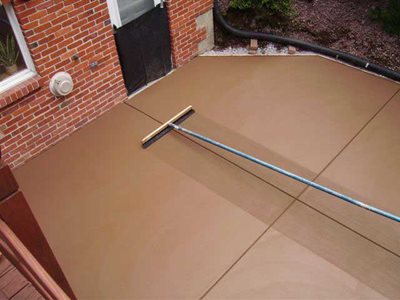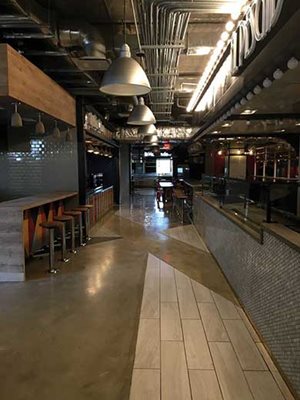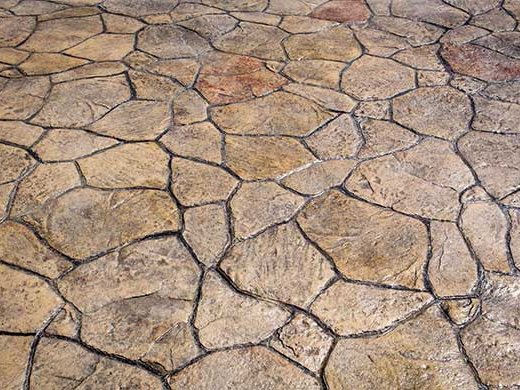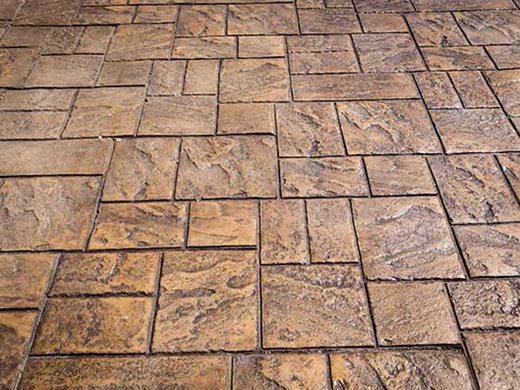Booth S11215
There are dozens of methods for finishing concrete. Most of these can be decorative and all of them are durable.

Broom finish concrete is almost certainly among the most common exterior concrete finishes. This slip-resistant finishing of concrete is a popular option for virtually every exterior concrete application. Sidewalks are commonly finished this way, for example. Pool decks, patios, and concrete pavement are also frequently broom finished. As the name implies, the distinct texture is achieved by dragging a broom across the surface of the concrete.
After troweling, while the concrete is still plastic, a specialized broom is pulled across the slab. Different brooms will leave different level of texture. This is where the small, parallel grooves come from. For a decorative but equally functional effect, finishers can use smaller brooms to create swirls, fans, and scalloped patterns. Broom finished concrete is easily upgraded with color. Use integral color, stains, or a combination of the two to turn utilitarian concrete into something understated and beautiful.
There are many methods for troweling concrete to a finish. These trowel finishes range from rough to almost glass smooth. On the rougher end of the spectrum, concrete is finished with a magnesium or wood float and that is it. These finishes may not be completely smooth or consolidated but they require little effort and offer a slightly textured surface.
Hard troweling is a common choice for interior concrete flooring. Whether you use hand or mechanical finishing of concrete, this is a great method for achieving a hard wearing, smooth surface. Hand troweling with a steel trowel requires more labor but it is good for getting the edge of the slab, small projects, and hard to reach places. A power trowel saves labor and achieves a tighter finish.
When hard troweling concrete, care must be taken to avoid burning the slab. This happens when a portion of the concrete is overworked, creating a distinct circular pattern and discoloration. Finishers must also be careful to avoid finishing in bleedwater or adding water as this can weaken and discolor concrete. The best way to aid the finishing of concrete is to use a purpose-made finishing aid like DAY1. This is especially true on colored concrete.

Polishing is a method for finishing of concrete where the surface is ground smooth. Chemicals are used to harden or densify the concrete. After densification, the concrete may be ground again and burnished to a smooth, shiny finish. Of all the methods for the finishing of concrete, polished concrete is one of the most economical and durable flooring options.
Polished concrete has a great capacity to be aesthetically pleasing, too. When specifying new polished concrete, integral color is a great choice. By coloring all of the concrete, it does not matter how much of the concrete is cut or ground away. The color will remain. Since a significant percentage of polished concrete is renovation, stains or penetrating dyes are the best option for adding color. They can also be used to create patterns and designs such as logos.
During the troweling stages, use DAY1 to aid the finishing of concrete that is to be polished. DAY1, used as a finishing aid, densifies the concrete and helps finishers get a smoother finish. This may reduce the amount grinding necessary and result in a better performing floor.
Rock salt finishes are a classic choice for concrete texturing. This timeless finish had fallen out of favor, but is regaining popularity in many warmer climates. Before the last pass of troweling, course rock salt is broadcast onto the concrete. When the concrete has cured, a power washer is used to remove the rock salt. This leaves a random pattern of small holes and pockets in the concrete surface. This is a low cost method of finishing of concrete that creates a non-skid surface. Unfortunately, creating voids in the surface of the concrete and introducing salts early on can negatively impact concrete durability. This is especially an issue in freeze thaw climates.
Another classic concrete finish gaining in popularity is exposed aggregate. As the name implies, this is a finish where sands and large aggregates are exposed by removing the upper layers of cement. In the past, there were three ways to achieve this finish: sandblasting, broadcasting aggregate, and sugar-based retarders. Each of these has a significant risk inconsistent finishes. Modern options, such as Surface Deactivator, make consistent and repeatable results easier.
Unlike a rock salt finish, exposed aggregate is resistant to freeze thaw issues. It provides an aesthetically pleasing finish that is functional as a skip resistant and durable surface. By exposing sands and aggregates, the concrete surface adds traction while exposing one the hardest parts of the concrete.


Stamped concrete driveways and patios are what you think of when you hear decorative concrete. Stamped concrete is one of the most versatile. This finish option uses urethane texturing tools to create a wide range of stone, slate, brick, and even wood patterns and textures. These decorative stamped finishes require a good deal of labor compared to other concrete finishes. However, compared to stone, brick and other pavers, stamped concrete is less labor intensive. This makes it an excellent choice for replacing these traditional materials without sacrificing appearance or durability.
Explore impressive concrete installations to find inspiration for your next project.
Find out how much color and fiber you'll need for any size project.